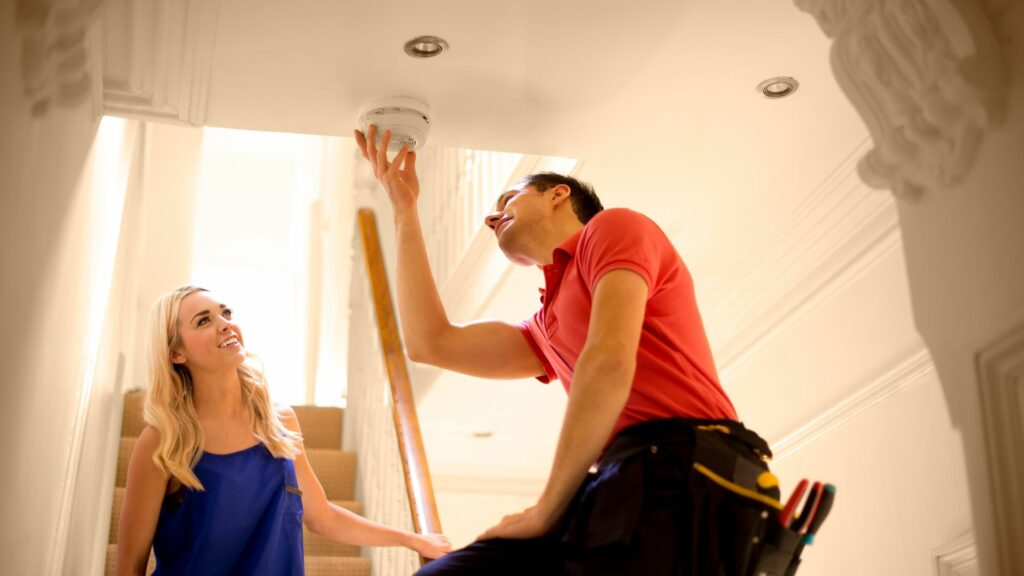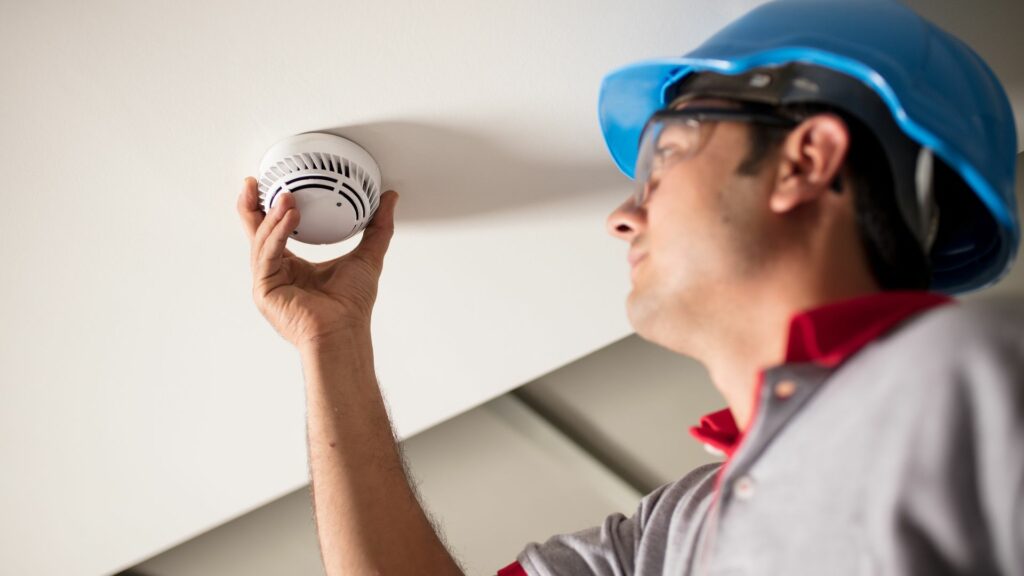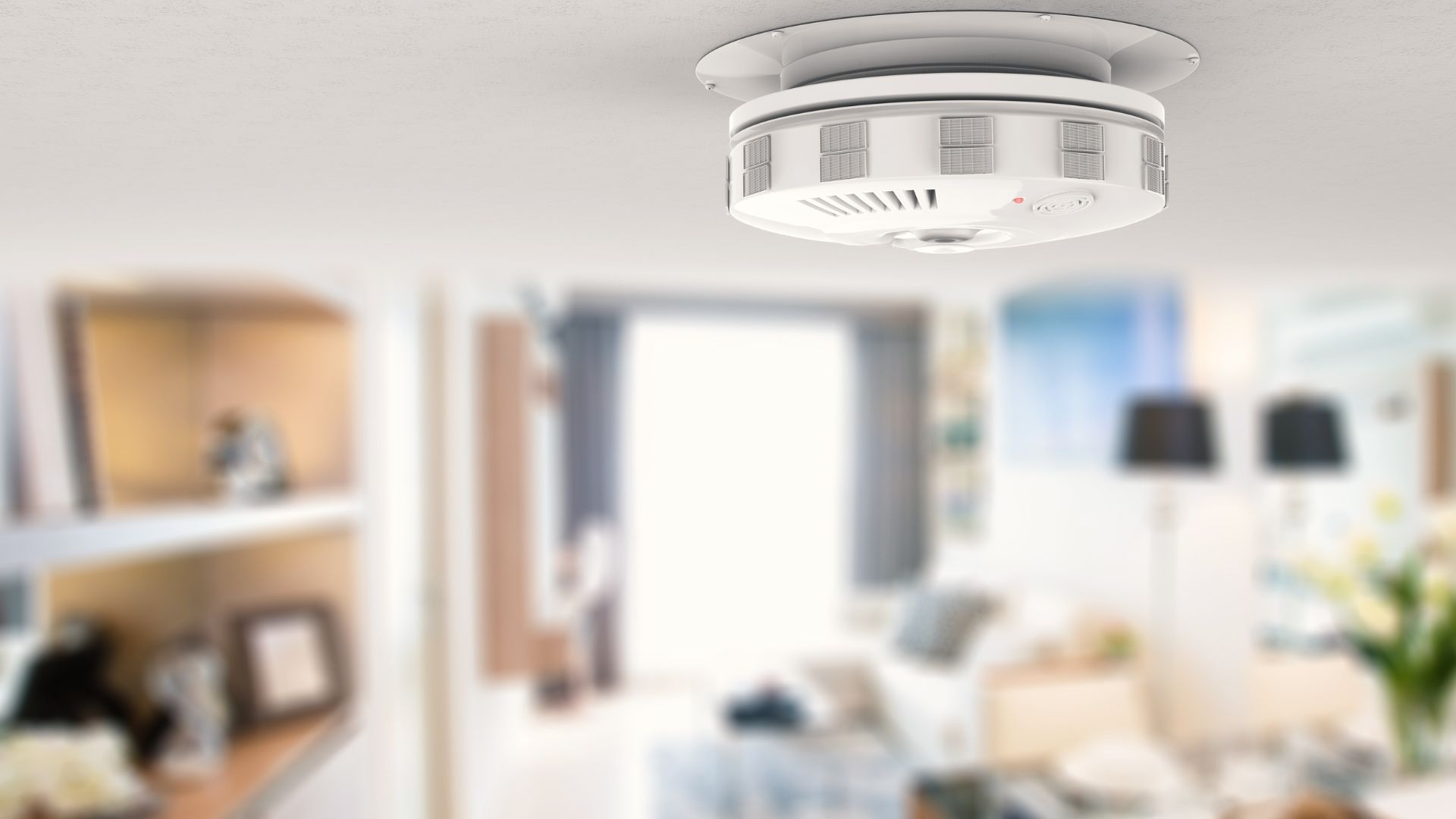Technically, you don’t have to install the smoke detector on the ceiling. However, this issue has several dimensions you must consider before determining the smoke alarm’s location. They include the following:
1). Types of Smoke Alarms
Many people use the term ‘Smoke Detector’ or ‘Smoke Alarm’ to refer to various devices. Smoke alarms are exactly what they sound like. You have a device on the wall or ceiling that generates a loud beeping when it detects smoke.
Carbon monoxide alarms are also aptly named because they respond to carbon monoxide. However, before you question their relevance to this discussion, you should know that many manufacturers combine carbon monoxide detectors and smoke alarms within the same device.
Heat alarms are another significant consideration because they will identify and warn you about notable heat sources before fires start. The type of alarm will affect the placement:
- The ceiling is a rational location for a smoke alarm because smoke rises. Therefore, it makes sense to place the smoke alarm in the area (highest point in the room) where the smoke will eventually accumulate.
- Carbon monoxide alarms will serve you best in the boiler room, assuming you have a boiler room. Kidde has noted that carbon monoxide disperses evenly because it has the same density as air. Therefore, the carbon monoxide will reach the alarm regardless of whether you place it on the ceiling or the wall.
- You should place heat alarms in the vicinity of areas with extreme temperatures. That includes the attic.
If your smoke alarm provides multiple functions, you must take those functions into account when choosing the location. For instance, even though smoke rises to the highest point, a smoke alarm with a carbon monoxide detector may serve you best on the wall in a boiler room.
2). What The Law Says?
You can’t just install the smoke detector wherever you see fit. You must abide by your area’s regulations. However, the law varies from location to location. For instance, the Scottish government expects consumers to mount smoke detectors on the ceiling.
You must install one in the living room, hallway, and landing. You should also add a heat alarm to the kitchen. Interlink these devices. You can place a carbon monoxide detector in rooms with carbon-fueled appliances, but you don’t have to interlink them with the other alarms in the house.
Check your area’s building code before you install the smoke detector. While most governments mandate the use of smoke alarms, the regulations governing the type and location will change.
3). Areas To Avoid
You need smoke detectors in all living areas and bedrooms. You should also install these devices between the sleeping areas and the other parts of the house. The Country Fire Authority in Victoria has published a diagram showing all the places that require smoke alarms in a conventional home.
However, it is worth noting that smoke alarms are not a perfect fit for every location. Try to avoid the following areas:
- The bathroom is problematic because the steam from a hot shower will trigger the smoke detector repeatedly. The steam can also damage the smoke detector. If you think the bathroom needs a smoke detector for some reason, place the device close to the bathroom but not inside.
- Stay away from fans. Laypeople think the fan blades are a problem. However, homeowners are not stupid enough to place a smoke detector within reach of the fan blades. The problem is the fan as a whole. It will put you in danger by blowing the smoke away from the smoke detector. The smoke detector won’t respond to fires.
- AC vents are equally annoying. Either they will blow the smoke away, or the heat will trigger the smoke detector.
- Stay away from the corners. Yes, smoke rises to the ceiling, but it doesn’t always drift to the corners. Therefore, placing smoke detectors in these dead-air spaces will prevent the devices from responding during the early stages of a fire.
- If you’re determined to install the smoke detector on the wall, don’t place it next to the window. Like the fan and AC vents, open windows allow drafts to blow the smoke away from the alarm.
- Kitchen appliances such as ovens and stoves produce too much heat and smoke. If the alarm is too close, expect a lot of nuisance tripping. Furnaces and water heaters present a similar challenge.
- The garage doesn’t suit smoke detectors because cars make smoke. The smoke from a car’s exhaust will trigger the alarm. Therefore, you should stick to heat alarms. A smoke detector will annoy you by repeatedly tripping. Attics are in a similar boat, especially if you haven’t finished them. The extreme temperatures will keep tripping the alarm.
You can see a pattern.
Any location that exposes the smoke detector to innocuous smoke and extreme temperatures or blows the smoke away is a bad idea.
Use your common sense. Take what you know about the workings of the smoke alarm and compare that knowledge to the environment.
Do the elements in the surroundings hinder or benefit the smoke detector’s work? If you can’t decide, talk to the local authorities and follow the regulations they provide.
Pros And Cons Of Installing Smoke Detector On Ceiling
You don’t really have a choice where smoke alarms are concerned. You don’t place these devices on the ceiling because the location is convenient. You install smoke detectors on the ceiling because the smoke will ascend to the ceiling before spreading out horizontally.
Therefore, the ceiling is the best location to detect smoke and warn you about fires before they spread. Even if the local regulations permit you to place the alarm on the wall, the ceiling is the superior option. The only disadvantage is the limited access.

Depending on your height (and the height of the ceiling), you need a ladder, chair, or table to reach the smoke detectors. Keep in mind that you must change the batteries in some smoke detectors every six months.
Where Else Can You Install Smoke Detector That Works Greater Than A Ceiling?
No other location is better than the ceiling. This is because the smoke will rise to the highest point, and the ceiling is the highest point in any given room.
If the ceiling isn’t an option, I suggest placing the device as close to the ceiling as possible. This leaves the wall as the only other option. Get as close to the ceiling as you can.
The local building code will have the final say. According to the National Fire Protection Association (NFPA), you can install a smoke detector on the ceiling or high on the wall (12 inches or less from the ceiling).
But if the local authorities disagree with the NFPA, obey the local regulations. They take priority. This is where technicians shine. They keep abreast of changes in local and federal regulations. Therefore, you can trust them to guide you accordingly.
Smoke Detector Placement Guidelines
1). Height

The height only matters if you wish to mount the smoke detector on the wall. In that case, the alarm can’t be lower than 12 inches from the ceiling. First Alert has a diagram showing the optimal location for a smoke detector on the wall.
If you have sloped ceilings such as the kind you see in cathedrals, place the alarms 500 to 1500mm from the ceiling’s highest location. Adjust the position to maintain a healthy distance between the smoke detector, windows, and ducts.
You don’t want drafts to interfere with the alarm. You should also steer clear of dead air spaces.
2). Location

- Place alarms in the center of the ceiling.
- The Victorian Building Authority wants a smoke detector between the bedrooms and the other sections of the house. You should also add an alarm to every bedroom and living area. These alarms should be interlinked so that an alert from one alarm triggers all the other alarms.
- Place an alarm on each level of your home.
- Mount the basement detector at the bottom of the stairs but still on the ceiling.
- Keep the smoke detector a minimum of three feet from a fan’s blades. While fans can interfere with the smoke alarm’s work, you can minimize that interference by keeping the device three or more feet away.
3). Proximity To Potential Fire Hazards
- Keep the device 5 – 15 feet away from appliances that burn fuel.
- Don’t install smoke detectors above AC units, heaters, or devices that generate steam, condensation, and hot fumes. They will cause nuisance tripping.
- Keep the alarm away from areas such as boiler rooms and unheated porches with excess heat or cold.
Smoke detectors have manuals. You should always check the manual to identify the best location for your model. However, the local regulations supersede the manual’s instructions. If the manual’s instructions differ from the local rules, mount the smoke alarm in the location the local authorities recommend.

